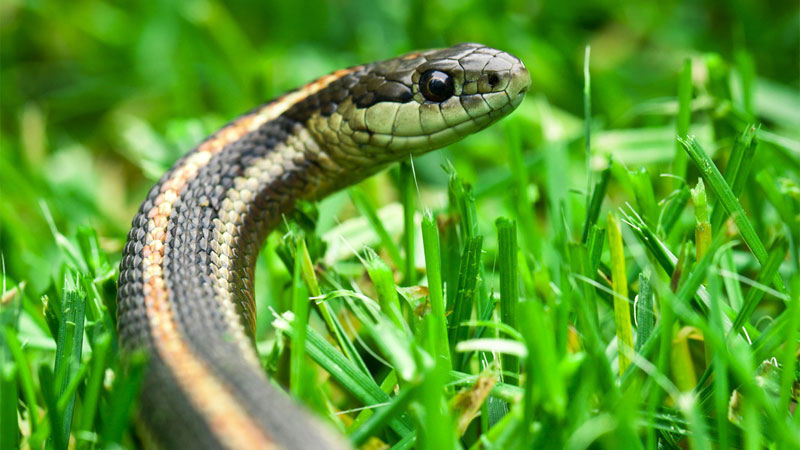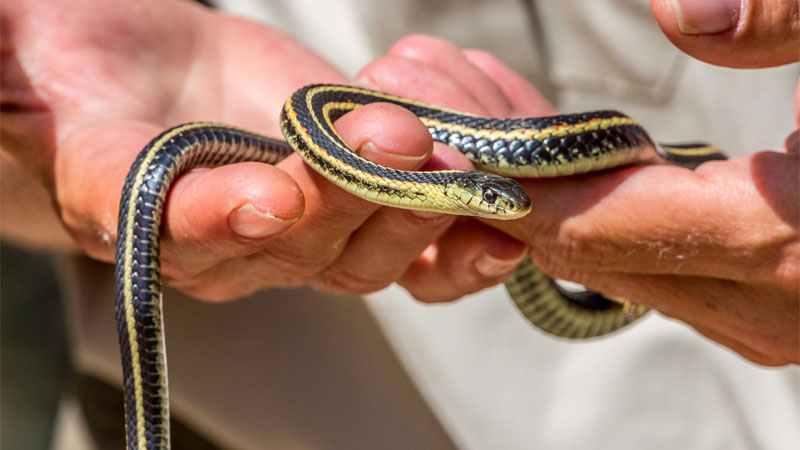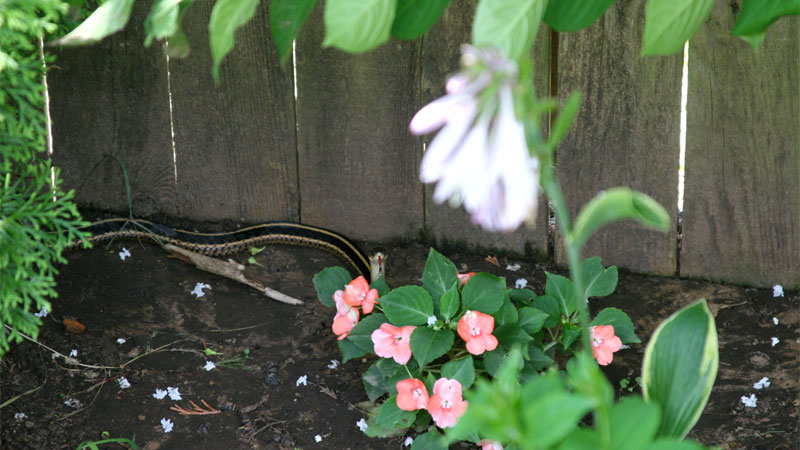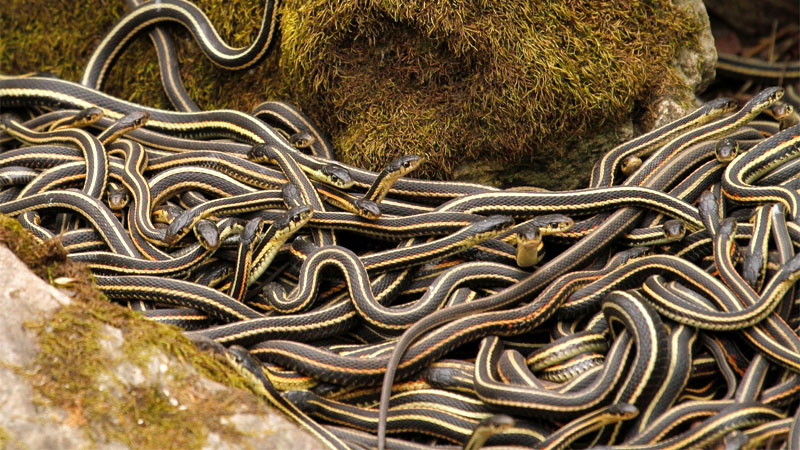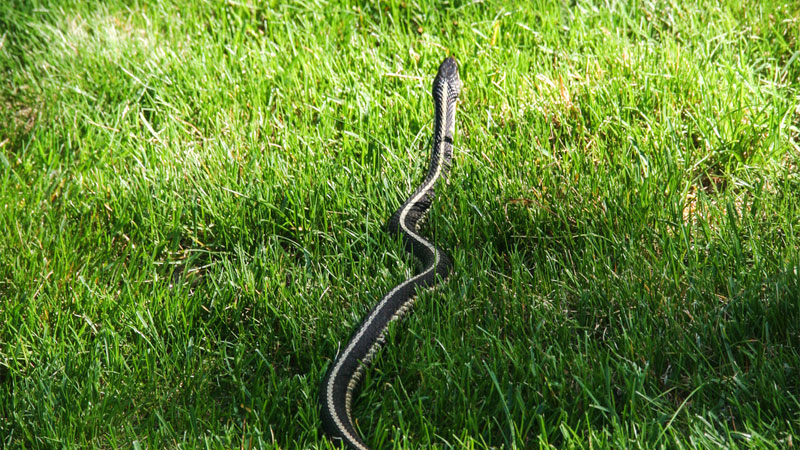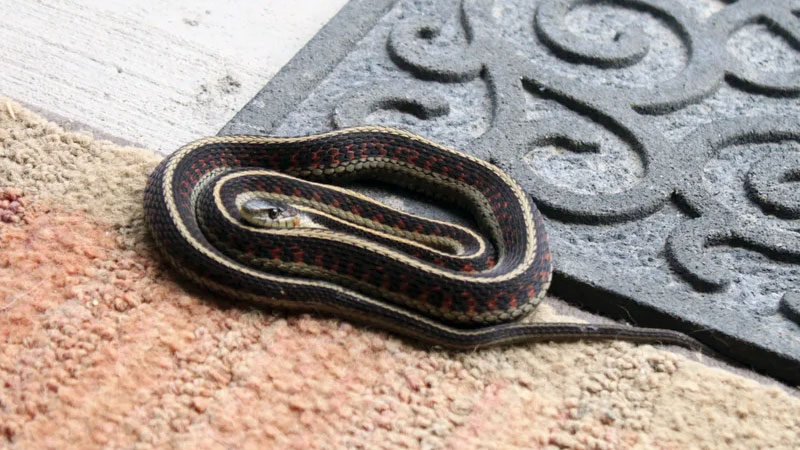If you’ve ever had a garden (or even just a back yard), there’s a good chance you’re going to have an encounter with a garter snake at some point. While pretty much harmless, these little guys can be pesky. The good news is that garter snacks are very different from what you might think by looking at them.
Unlike many snakes, you can deal with these little guys without resorting to violence. Here’s everything you need to know to get rid of any garter snakes in your home or property.
Getting to Know Garter Snakes
Garter snakes are surprisingly common and there’s a good chance you’ve walked right beside one before without even noticing. In fact, there are many cases where people have stepped on these little snakes without even noticing.
Why Are They Called Garter Snakes, Anyway?
This has been a question haunting people since Carl Linneas identified the eastern garter snake (Thamnophis sirtalis sirtalis) in 1758.
This name is curious because it literally translates to “bush snake like a garter”. However, whether or not the esteemed botanist intended the name to refer to the striping or how it resembled a garter strap is unknown.
It’s entirely possible the association with garters was accidental or possibly even based on a Native American pointing to a garter when describing the snake to Linneas. Sadly, this is just another mystery that may never be solved.
How To Identify a Garter Snake
With 35 species and subspecies, the Thamnophis genus has a lot of variety, making it difficult to give any single description. However, garter snakes tend to share many or most of the following traits:
- 18 to 51 inches in length
- Keeled scales on a slender body
- Lack of prominent fangs
- Round eyes and pupils
- Round head
- Stripes down their length, sometimes accompanies by spots
Telling Garter Snakes From Venomous Snakes
There are a few ways to immediately tell if a snake might be venomous. These dangerous snakes have clear markings, such as the red and yellow bands of a coral snake, the diamond pattern of a diamondback, or the rattle of a rattlesnake.
Also a non-venomous snake’s head will be round and often spoon-shaped, whereas a poisonous species of snake (like a rattlesnake or copperhead) will tend to have a more angular or triangular head.
Of course, garters and many other non-venomous species have learned to flatten their bodies to give the appearance of a venomous snake, so when you see any snake with such a shape, always treat it as if it was dangerous.
The final difference is in the eyes. Don’t try to get too close to a snake, but if you have your phone, you can use the zoom to check the pupil shape. Venomous snakes have slit-shaped pupils while non-venomous snakes have round pupils.
Can Garter Snakes Bite? And Are They Venomous?
While not easily visible, garter snakes do have teeth and can bite if threatened. However, the teeth are quite small and while the bite may hurt, it’s harmless.
In fact, it wasn’t until quite recently that scientists discovered that garter snakes produce venom. The dosage is so weak that to this day, garter snakes are considered non-venomous.
Habitat
Garter snakes are native to North America and can be found throughout most of the continent with the exception of the northern half of Canada where it’s too cold for reptiles to function. Due to their need for access to water sources, they’re not found in the desert. However, they’re well-adapted to forests, grasslands, and wetlands.
Species in the eastern half of the continent are less aquatic than those in the western half. Despite this, all species prefer to be near water.
Can Garter Snakes Swim?
Garter snakes are incredibly good swimmers to the point they’re often confused with their close relatives, the water sakes (Nerodia genus). This similarity, along with others, has resulted in several species being swapped back and forth between the two genera.
Diet
There are three things on the average garter snake’s menu: amphibians, insects, and small mammals such as mice. This means they can make a good ally when it comes to pest control. More importantly, they’ll actually attack and eat venomous species.
Signs of Garter Snake Activity
Garters may try to hide, but they’re not very good at covering their tracks – literally and figuratively. For example you might discover snake tracks in mud or dirt. It’s also possible to spot snake droppings where they’ve been hanging out. The droppings often contain bits of undigested food.
Even more apparent is the strong, nasty odor that can betray their position. Finally, you might discover their shed skin, although this is fairly rare.
Why Are There Garter Snakes in My Home?
If you see a garter in your home during the winter, it might be coming in for the heat. These snakes are generally solitary but will huddle in large groups for warmth while they hibernate for the winter. So if a solitary snake can’t find a huddle, he’ll settle for your home.
Another common reason for garters to wander in is if you have an infestation on your hands. You might not notice those mice in your walls, but the snake’s acute sense of smell will detect they’re there and it’ll sneak in for an easy meal.
Common Garter Snake Hiding Spots
These shy little critters prefer to remain hidden unless there’s a nice spot for basking. Outdoor hiding spots include tall vegetation, under rocks, crawl spaces under decks, or wood piles. They can also be considered a common type of garden snake, as your garden is often prime hunting grounds.
If they get inside your home, you’ll usually find the snake in your basement. On some occasions, an invading garter snake will wind up in your kitchen or bathroom, attracted by the moisture.
Can Garter Snakes Climb Stairs or Walls?
While they aren’t likely to scale a building, garter snakes are excellent climbers if the surface has enough texture. They can even raise themselves high enough to climb stairs. However, this isn’t something they do for fun and you’ll generally only see a garter snake doing this if there’s food or safety involved.
Benefits of Garter Snakes
When allowed to hang out in your garden, garter snakes will hunt down a wide range of pests without harming your plants. They’re no threat to humans and prefer to stay out of your way when possible. As result, they’re an excellent ally to keep around.
While they are also known to feed on beneficial insects, this is far less common since snakes are more likely to go after food sources near the ground.
Risks of Garter Snakes
Garter snakes communicate through a range of pheromones, allowing them to track other snakes, as well as mate. Interestingly, male garter snakes have pheromones very different from females, yet the males in some species can actually mimic a female’s hormones to trick other males into sharing body heat.
Unfortunately, these pheromones also mean that garter snakes leave behind quite the unpleasant odor. They can also secrete the smell anally as a defense.
Here are a few other potential downsides to these generally harmless snakes:
- Bites can become infected or trigger a saliva allergy.
- Their diet may include earthworms, beneficial insects, chicken eggs, or even chicks.
- Due to the small size, even tiny entry points can be big enough for a garter snake (hence the reason that little guy was staring at you from the shelf.).
- They hibernate in piles that can have hundreds of individual snakes.
Garter Snakes vs Rat Snakes
Hailing from the family Colubridae, rat snakes tend to have a dark body with lighter underside. They’re much better climbers than garters and will readily scale trees to hunt bird nests or find shelter. However, as the name suggests, rat snakes are constrictors that primarily hunt rodents.
Much like garters, rat snakes were only recently discovered to produce venom, but are considered totally harmless. The corn snake is a popular example of a rat snake.
Garter Snakes vs Ribbon Snakes
Unlike water snakes, which are so similar even the experts can mix them up, ribbon snakes have a few differences from the garter snake.
They have a much longer tail and smaller head. Their extra thin bodies also have a different stripe pattern. A little white spot is in front of each eye. However, their other habits and foul odor are nearly identical to that of a garter snake.
Getting Rid of Garter Snakes
While a garter snake is pretty much harmless, you don’t want to risk having a couple hundred of them hibernating under your porch come October. The good news is that they’re fairly easy to get rid of regardless of your reason for doing so. The bad news is that smell tends to stick around and is tougher to eliminate than skunk musk.
Natural Predators
One thing you might not be aware of is the fact that garters have several natural predators you can invite onto your property to keep the population down.
Nowadays, more and more urban and even rural environments have been importing predator birds to help deal with the explosion of rock doves (AKA pigeons), and many of these birds will actively go after garter snakes.
Raptors and other snake-eating birds you can attract include:
Does this list surprise you?
Be warned that some of the birds on this list can also become problematic, so employ with caution. For example, raptors (eagles, falcons, and hawks) can be a threat to small pets, so don’t invite them if you have toy dogs or small cats.
However, the big shocker for most people is to learn that chickens are a predator species. Chickens not only eat snakes, but they’ll go after lizards, mice, rats, and even small birds! Just be warned that garters can go after chicks, so only let the adults out to hunt.
You can also employ a number of other critters to your cause, although these again should be used with caution since some are pests in their own right:
- Bullfrogs
- Cats
- Dogs (although the defensive anal discharge may result in vomiting the meal)
- Foxes (fox urine crystals can also be used as a deterrent)
- Opossums
- Raccoons
- Skunks
- Other snakes (such as the coral snake and kingsnake)
- Snapping turtles
Getting Garter Snakes Out of the House
A humane bait trap is perhaps the best way to go. The trap will need either live bait or may include bait if bought. Be sure to camouflage the trap so the snakes won’t avoid it.
While you can use these traps outdoors as well, they’re perfect for the home because you won’t have to handle the snake. Be sure to relocate the little guy somewhere a few miles away before releasing him.
Once the snake’s gone, be sure to do a thorough inspection of your home’s exterior and seal any possible entry points such as holes, crevasses, putting mesh over vents, etc.
Removing a Garter Snake Den
Known as a hubernacula, these dens are usually found somewhere warm and secluded. This means garter snake infestations can be in sheltered such as under a porch or even in an attic. Remove the snakes one-by-one (this can take a while) and put them somewhere far from your home
You may wish to wear gloves (so you won’t smell after) and keep in mind the cold can kill garter snakes, so plan your relocation carefully if you want to keep them alive. Be sure to seal any entry points to the den afterwards.
Chasing Garter Snakes Away (and Keeping Them Away)
Garter snakes want the same things that most critters do: food, water, warmth, and shelter. Thus, the trick to keeping them off your property is to deny them these amenities. You can also usually chase a snake out in the process.
- Keep the lawn short and any plants properly pruned. This makes it harder for snakes to hide while simultaneously chasing away a lot of the larger pests these snakes like to eat.
- Keep your property clear of debris, including any large rocks. This also means keeping any wood pile away from your home.
- There are a number of artificial and natural snake repellents out there, from chemicals to herbs and animal urine crystals. Be warned, they’re not always pleasant to humans.
- Snake fences are short barriers of smooth material or mesh that will either cause the snake to get stuck or be at an angle they can’t scale. These need to be places around your property’s perimeter and are sometimes expensive, but they may help deter other pests as well.
- Use complimentary gardening. Aromatic plants such as cloves, garlic lavender, lemongrass, marigolds mint, and onion will not only deter snakes, but also their prey.
- Smoke reminds snakes of danger and they’ll actively flee an area that smells like smoke.
- Remove any standing water on the property and make water features inhospitable to snakes such as a vinegar perimeter or barrier of repellent plants.
- Add gravel or other uneven surfaces which irritate the snakes.
- Fill in any holes or burrows, as the snakes will often reuse these.
- How to Get Rid of Hawks - March 8, 2024
- How to Get Rid of Pill Bugs (Rolly Pollies) - March 1, 2024
- How to Get Rid of Groundhogs (Woodchucks) - February 5, 2024

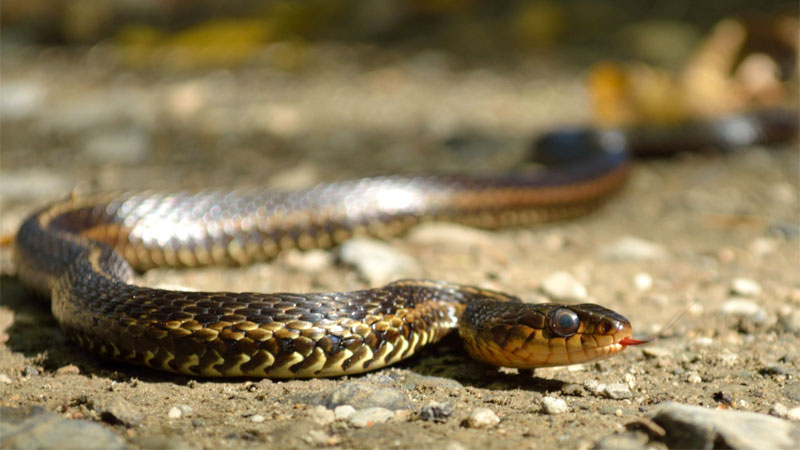
 Just tell me how to get rid of ’em.
Just tell me how to get rid of ’em.